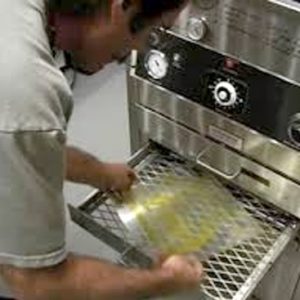Printing Plate Equipment
 Photopolymer printing plate systems are generally processed in three basic steps:
Photopolymer printing plate systems are generally processed in three basic steps:
- Pre-Exposure Processing
- Exposure Processing
- Development or washout. A special equipment may be required for each step.
Pre-Exposure Processing
Solid printing plates, which are ready to be imaged, do not require any pre-exposure processing. Manufacturers of liquid photopolymers also supply suitable processing equipment for their plates. These generally include resin application, exposure and washout steps in one unit. Separate units are also available for small users, as for the hand stamp market.
A typical large platemaking system for liquid photopolymers can make plates with 52” x 80” image area. It can make plates in thickness ranging from 0.017 inch to 0.280 inch. An in-line processing unit for the imaged plates simplifies handling of such large plates. All new platemaking equipment is computer-controlled and is Internet-accessible for remote diagnostics and programming correction. The first step in the plate- processing is placement of a negative on the glass plate of the equipment. The negative is covered with a thin transparent plastic film. The photopolymer is then pumped over the cover film and levelled automatically to a proper thickness. At the same time, the plate substrate (polyester film) is rolled over the polymer. The plate is then ready for exposure from both sides. The top exposure, without a negative, with limited penetration, provides a hardened base layer, while the bottom exposure, through the negative, provides the relief image.
In an alternate system, the liquid photopolymer is metered upon polyester film, aluminum foil or paper placed on a vacuum platen. Exposure is done off-contact.
Exposure Equipment
Fluorescent light as well as all types of high intensity UV sources are used for exposure. Exposure times vary from less than a minute to up to 12 minutes depending upon the type of source, photopolymer and thickness. Most of the relief plates also require a short “back exposure” for improved adhesion to the substrate. Litho plates have a very thin coating, so they can be exposed in ½ to 2 minutes. Flexographic plates, which are up to 250 mils thick, require up to 30 minutes for black light exposure. The size of equipment varies from a table top model to a freestanding automatic unit, processing up to 240 plates/hour.
Laser exposure systems are now available. These are basically used for computer-to-plate systems. Most computer-to-plate systems for lithographic plates use thermal plates, which are not based on photopolymers. Thermal exposure is done at 800-1200 nm. New violet-light (405-410 nm) imaging systems have now given fresh life to photopolymer systems. Sometimes also called “blue” or “violet” laser diodes, these low-cost, solid-state semiconductor devices emit energy at 405-410 nm in the violet / low-UV wavelength range.
Post-Exposure Processing
The relief-plate-making system is generally sold as a system that includes an exposure unit and a developing unit. They are often combined in a single equipment for a fully automatic operation. Development is done in water, aqueous solutions or solvents.
Some letterpress polyamide relief plates use tap water. Another uses 85:15 ethanol/water mixture. Flexographic plates are usually developed in hydrocarbon-based solvent mixtures or aqueous solutions. In newer flexographic systems the plates after exposure are developed by removing the unexposed photopolymer by melting it away and absorbing it in a medium.
The wet-processing equipment generally incorporates spray nozzles and a flatbed or a rotating drum to hold the plates. Output of the development/ washout units varies from less than 5 plates per hour to about 240 plates/hour.
After development, the plates are dried in either the same equipment or separate units. Most solvent-based systems have separate drawer-type drying ovens.
After drying, plates may require additional treatment. For example, some flexo plates are dipped for 5 minutes in a chemical solution to eliminate surface tack. Some plates are given a post-exposure of UV light for 2-10 minutes in either the exposure unit or a separate post-exposure unit, to harden the image. Some companies also offer solvent recovery units.
Lithographic plates can be developed manually or with automatic processors. The latter can develop and finish plates up to 60″ wide and of any length.
Copyright © 2009 Savla Associates

